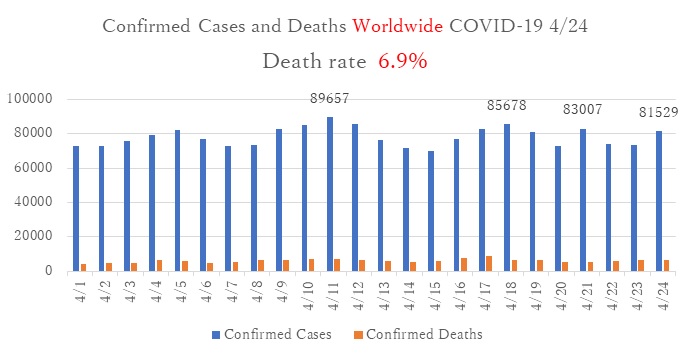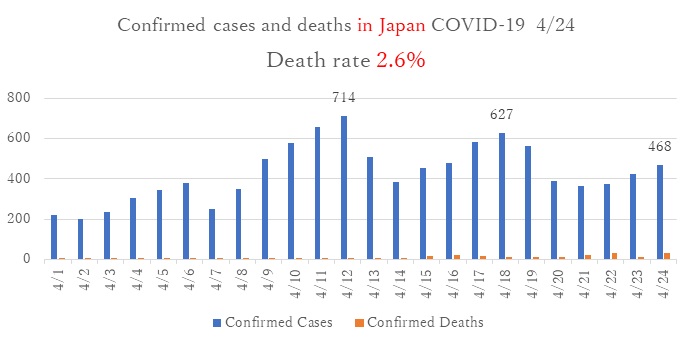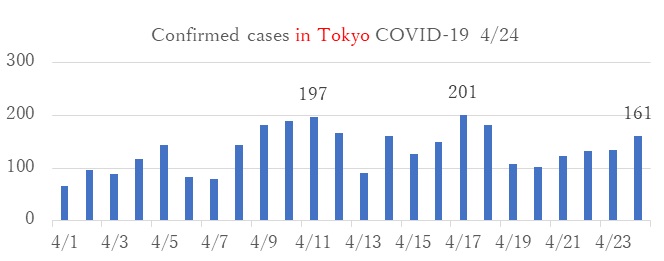SHARE
Services for the Health in Asian & African Regions (SHARE) = SHARE is a citizen sector organization (NGO) that engages in international cooperation mainly through providing health service.
HOME > News > Information of COVID-19(5)
- 【※updated】COVID-19(multi-language)
- Information of COVID-19(15)
- Information of COVID-19(vaccines)
- 《Request to the Government of Japan》Ease the protection of intellectual property rights and promote sharing and cooperating on pharmaceuticals and medical technologies, in order to accelerate efforts to overcome COVID-19 all over the world.
- Information of COVID-19(14)
- Information of COVID-19(13)
- Information of COVID-19(12)
- Information of COVID-19(11)
- SHARE Medical Information Line for Migrants is resumed in Oct.
- Information of COVID-19(10)
Information of COVID-19(5)

Information of COVID-19 (5)by SHARE 2020.04.27
1.Global and Japanese Situation of COVID-19
Confirmed cases of COVID-19 worldwide according to reports by WHO Update 2020/4/27 (Japan Standard Time) : Ministry of Health, Labor and Welfare (MHLW)

Tokyo 2020/4/24 (Japan Standard Time): Tokyo Prefecture Report

2.COVID-19 treatment for foreign residents in Japan
- Act on the Prevention of Infectious Diseases and Medical Care for Patients with Infectious Disease (The Infectious Diseases Control Law) was amended (Article 6. Item 8) to include COVID-19 as designated infectious disease.
- According to the Infectious Disease Control Law, the government covers the cost of COVID-19 medical treatments at hospitals and designated facilities. The patients may need to pay a maximum of 20,000 yen per month depending on household income.
- The cost of PCR testing is also covered, if it is ordered by the designated doctor (regardless of testing results).
- The cost of treatment before the isolation or without isolation will not be covered by government. Therefore, a patient with public health insurance need to pay 30% of the cost. If a patient without health insurance need to shoulder total amount of the cost.
- The Infectious Diseases Control Law covers all residents in Japan regardless of nationalities, resident's status, enlist in public health insurance.
Reference:
https://www.mhlw.go.jp/content/10900000/000589747.pdf
https://news.yahoo.co.jp/byline/kutsunasatoshi/20200127-00160618/
3.Management of the patients with mild cases
- Up until now, the confirmed cases have been treated at hospitals. Hospitals must keep available beds for severe cases as the number of confirmed cases is increasing. Therefore, the mild case patient will be transferred to the designated facilities.
- The mild case excludes (1) senior citizens, (2) persons with underlying health conditions (e.g., diabetes mellitus, cardiovascular disease, pulmonary disease, dialysis treatment), (3) persons with immunosuppressive (e.g., immune-suppressing drug, anticancer drug), and (4) pregnant women.
- • The mild case patients will be diagnosed by medical doctors of whether the patients will be hospitalized or who will send to medical facilities for PCR test. The doctors are also in charge of decisions of discharges from the designated facilities.
- The mild case patients will stay at the facilities designated by prefectural and city governments. The patients will stay until PCR test show negative twice continuously (this process takes approximately 14 days).
- The mild case patients are not allowed to leave the designated facilities. The cost of stay will be covered by the government, including meals. The patients might be charged for laundries (depends on the facilities).
- Nurses in charge of the designated facilities check patients' health condition regularly. In the case of worsening the health condition, the patients will be referred to hospitals.
Reference: https://www.mhlw.go.jp/content/000625171.pdf
4.Border controls
- Measures against COVID-19 consist of prevention, diagnosis, isolation, and treatment. The border control is part of infection preventions to avoid further spread of infections by fever checking, interviewing, and providing necessary inspections to travelers.
- On March 18th, "New measures to tighten border controls were decided to take proactive measures aligning with measures taken by foreign countries.
- According to information on the risk of infection by MOFA[1] , travelers from countries above level 3 are subject of the border control. The travelers from countries on the list, the are asked to self-isolate at designated facilities by the quarantine station chief. All travelers must take PCR test, and the positive patients will be isolated and be monitored for fourteen days at hotels nearby the airports.
- Keio university hospital reported that among preoperative and prehospital patients, 6% positive asymptomatic patients were identified by PCR test. Although the test was conducted within one hospital, it infers that community-acquired infection in Tokyo metropolitan is about 6%. The actual infection rate among the population will be clarified by the proposed antibody test survey.
- The ongoing prevention strategies are combination of border controls to avoid new infection imported from outside of Japan, and infection preventions among residents in Japan through social distancing.
Reference: https://news.yahoo.co.jp/byline/egawashoko/20200213-00162972/
[1]The level (from 1 to 4) of the risk of infection are shown by the map in MOFA website.
https://www.anzen.mofa.go.jp
Written by Nakasa T, MD, Co-President of SHARE
Koto K, RN, SHARE advisor
Koto K, RN, SHARE advisor
■English Information
-
Information of COVID-19(1)(ENGLISH)
-
Information of COVID-19(2)(ENGLISH)
-
Information of COVID-19(3)(ENGLISH)
-
Information of COVID-19(4)(ENGLISH)
-
Information of COVID-19(5)(ENGLISH)
-
Information of COVID-19(6)(ENGLISH)
-
Information of COVID-19(7)(ENGLISH)
-
Information of COVID-19(8)(ENGLISH)
-
Information of COVID-19(9)(ENGLISH)
■Useful URLs by multi-languages




